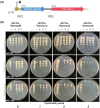A genome-wide overexpression screen reveals Mycobacterium smegmatis growth inhibitors encoded by mycobacteriophage Hammy
- PMID: 37934806
- PMCID: PMC10700055
- DOI: 10.1093/g3journal/jkad240
A genome-wide overexpression screen reveals Mycobacterium smegmatis growth inhibitors encoded by mycobacteriophage Hammy
Abstract
During infection, bacteriophages produce diverse gene products to overcome bacterial antiphage defenses, to outcompete other phages, and to take over cellular processes. Even in the best-studied model phages, the roles of most phage-encoded gene products are unknown, and the phage population represents a largely untapped reservoir of novel gene functions. Considering the sheer size of this population, experimental screening methods are needed to sort through the enormous collection of available sequences and identify gene products that can modulate bacterial behavior for downstream functional characterization. Here, we describe the construction of a plasmid-based overexpression library of 94 genes encoded by Hammy, a Cluster K mycobacteriophage closely related to those infecting clinically important mycobacteria. The arrayed library was systematically screened in a plate-based cytotoxicity assay, identifying a diverse set of 24 gene products (representing ∼25% of the Hammy genome) capable of inhibiting growth of the host bacterium Mycobacterium smegmatis. Half of these are related to growth inhibitors previously identified in related phage Waterfoul, supporting their functional conservation; the other genes represent novel additions to the list of known antimycobacterial growth inhibitors. This work, conducted as part of the HHMI-supported Science Education Alliance Gene-function Exploration by a Network of Emerging Scientists (SEA-GENES) project, highlights the value of parallel, comprehensive overexpression screens in exploring genome-wide patterns of phage gene function and novel interactions between phages and their hosts.
Keywords: Mycobacterium smegmatis; cytotoxicity; mycobacteriophage.
© The Author(s) 2023. Published by Oxford University Press on behalf of The Genetics Society of America.
Conflict of interest statement
Conflicts of interest statement The authors declare no conflict of interest.
Figures




References
-
- Anders KR, Barekzi N, Best AA, Frederick GD, Mavrodi DV, Vazquez E; SEA-PHAGES; Amoh NYA, Baliraine FN, Buchser WJ, et al. . 2017. Genome sequences of mycobacteriophages amgine, amohnition, Bella96, cain, DarthP, Hammy, krueger, LastHope, peanam, PhelpsODU, phrank, SirPhilip, slimphazie, and unicorn. Genome Announc. 5(49):e01202–17. doi:10.1128/genomeA.01202-17. - DOI - PMC - PubMed
Publication types
MeSH terms
Grants and funding
LinkOut - more resources
Full Text Sources
